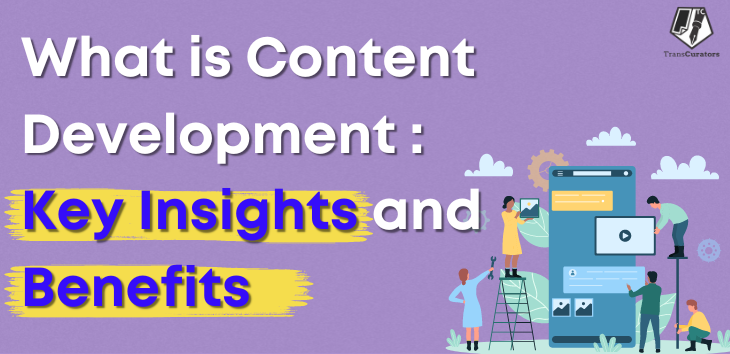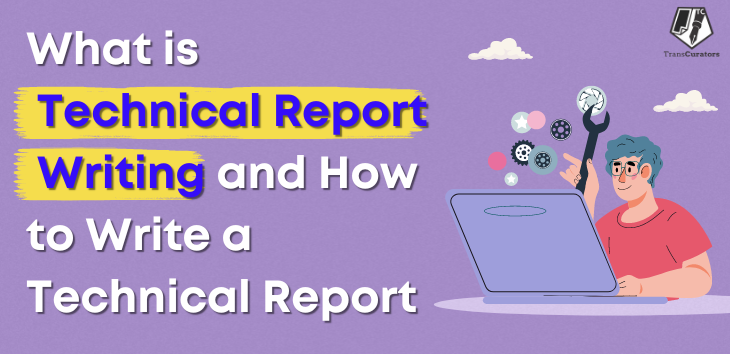
In today’s digital world, content is more than just words on a screen; it is the cornerstone of effective communication, the link between businesses and their customers, and an effective tool for engagement and growth. Content development is researching, creating, refining, and maintaining content to achieve specific objectives and attract target audiences. Understanding the technical aspects of content development is critical for any marketer, writer, or business proprietor trying to enhance their online presence. In this blog, we will explore the world of content development and its process and learn about the importance of content development
What is Content Development?
Content development is the process of creating, curating, and managing various types of content to satisfy the demands and interests of an intended audience. This includes blog posts, articles, videos, infographics, podcasts, and social media updates. Content development aims to provide meaningful and entertaining information that connects with your target audience, encourages engagement, and drives people to action. Content development is a comprehensive approach to establishing significant connections with your audience by constantly delivering substantial and entertaining content. Focusing on your audience’s requirements and interests will help you improve your brand’s exposure, credibility, and overall success.
Importance of Content Development
Here are several reasons why content development is essential:
1. Establishes Brand Authority
You establish your brand’s authority in your industry when you continuously create high-quality, helpful content. People look to your content for answers and information, which builds trust. Over time, trust develops into loyalty. Customers prefer brands that provide reliable and helpful information. This credibility improves your reputation and positions your brand as a leader.
2. Engages the Audience
Effective development generation helps you to establish a deeper connection with your audience. You retain and keep their interest by addressing their needs and problems. Engaging content creates an impression of community and fosters engagement. Whether through comments, shares, or discussions, audience interaction can result in stronger relationships and a more loyal following.
3. Drives Traffic and Leads
Well-developed content persuades readers to visit your website. By optimising your content for search engines, you can boost its visibility and attract organic visitors. Engaging and valuable content keeps visitors on your website longer, which reduces bounce rates. More significantly, it turns visitors into leads. Your content can entice readers to take the next step by including appealing calls to action and beneficial offers, such as signing up for a newsletter, downloading a resource, or purchasing.
4. Enhances SEO
Search engines like high-quality, relevant information. You boost your search engine rankings by developing content that meets your audience’s search intent. This approach includes effectively using keywords, meta descriptions, and internal links. Higher rankings result in higher visibility and organic traffic. SEO-optimised content guarantees that your intended audience finds you when they search for information about your products or services.
5. Promotes Brand Awareness
Content development increases your brand’s visibility. You can reach a larger audience by creating and posting content on multiple platforms. Each piece of content acts as a point of contact for potential customers. As more people see and interact with your content, they get acquainted with your brand. Increased awareness can result in better recognition and recall, which is critical for long-term business success.
Content development is an intricate process required for any business to thrive in the Internet age. It builds brand authority, engages audiences, generates traffic and leads, and aids marketing and sales operations. Content development is essential for long-term business achievement since it improves SEO, raises brand awareness, and educates your audience. Focusing on exceptional, relevant, engaging content will help your company stand out and connect meaningfully with your target audience.
What is the Content Development Process? Step-by Step
Content creation is vital for creating meaningful, exciting content that grabs and retains an audience’s attention. This process consists of several crucial steps, each focused on delivering excellent content that fulfils specific objectives. Let’s explore the content development process in detail.
Step 1: Ideation and Research
The first stage in content development is creativity. You brainstorm ideas that are relevant to your target audience. Consider which topics will be entertaining, appropriate, and helpful to them. Research to make sure that reliable facts and statistics support your ideas. This entails analysing current trends, audience preferences, and competitors’ actions. Use resources such as Google Trends, social media insights, and industry studies for collecting information.
Key Actions:
- Brainstorm potential topics.
- Research audience interests and needs.
- Analyse competitors’ content.
Step 2: Planning and Strategy
Create a content strategy once you’ve written your list of ideas. This strategy defines what content you will create, when it will be published, and how it will be shared. A well-structured plan connects your content to your business’s objectives and audience preferences. Consider developing a content calendar to help you plan your pieces and maintain consistency.
Key Actions:
- Develop a content calendar.
- Align content with business objectives.
- Decide on content types and formats.
Step 3: Content Creation
Content creation is the heart of the process. Based on your plan, start producing the content. This includes writing blog posts, recording videos, generating infographics, or publishing social media posts. Concentrate on providing high-quality content that is informative, engaging and helpful to your target audience. Make sure the content is original and offers a unique perspective or solution.
Key Actions:
- Write, record, or design the content.
- Ensure originality and quality.
- Address audience pain points and interests.
Step 4: Editing and Proofreading
After you’ve written the content, you must modify and proofread it. Editing involves reviewing the content for clarity, coherence, and consistency. Check for factual correctness and make sure the content flows logically. Proofreading is the final step for detecting grammatical, spelling, and punctuation errors. This step guarantees that your content is clean and professional.
Key Actions:
- Edit for clarity and coherence.
- Verify factual accuracy.
- Proofread for grammatical errors.
Step 5: Optimization
To maximise the reach and impact of your content:
Optimise your content for search engines (SEO). Use keywords that your target audience is likely searching for. Improve search engine visibility by optimising titles, meta descriptions, and headers. Make sure your material is easy to read and mobile-friendly. Incorporate internal and external links to increase value and boost SEO.
Key Actions:
- Use relevant keywords.
- Optimise titles and meta descriptions.
- Ensure readability and mobile compatibility.
Step 6: Publishing
After you’ve created and optimised the content, it’s time to publish it. Choose the appropriate platform for your content, whether your website, blog, social media, or a different platform. The timing of your publishing can influence its success, so consider when your audience is most engaged and likely to engage.
Key Actions:
- Select appropriate platforms.
- Schedule posts for optimal timing.
- Ensure seamless publishing.
Step 7: Promotion
Promoting your content is critical to reaching a larger audience. Share your work across social media, email newsletters, and online communities. Engage your audience by answering o comments and encouraging them to share. Collaborate with influencers or other companies to expand your reach.
Key Actions:
- Share content on social media.
- Send email newsletters.
- Engage with your audience and encourage sharing.
Step 8: Analysis and Improvement
After publishing and promoting your content, analyse its performance. Use analytics tools to track metrics such as views, shares, comments, and conversion rates. Assess what worked well and what didn’t. Use this data to refine your content strategy and make improvements in future content development efforts.
Key Actions:
- Track performance metrics.
- Analyse audience engagement.
- Adjust strategy based on insights.
Best Practices in Content Development
Understand Your Audience
Knowing your audience is essential for creating excellent content. Surveys, social listening, and analytics can all assist you in learning more about your target audience’s preferences and behaviours. Tailor your content to meet their specific requirements and interests.
Create Valuable Content
Focus on delivering value to your audience. Your content should be informative, entertaining, or address an issue. High-value content keeps your audience interested and returning for more.
Maintain Consistency
Consistency in content creation and publication fosters trust and keeps your audience interested. Maintain a consistent voice and tone that aligns with your brand.
Leverage Different Content Formats
Different audiences prefer various content formats. Experiment with other sorts of content, such as blog posts, videos, infographics, podcasts, and social media posts, to figure out what works best for your audience.
Optimise for SEO
SEO is necessary for driving organic traffic to your content. Use relevant keywords, optimise meta tags, and make your content easy to explore. SEO optimization helps your content rank higher in search engine results, which increases visibility.
Know more about SEO Content Writing.
Engage with Your Audience
Engagement is essential for developing a committed audience. Respond to comments, encourage feedback, and produce engaging content that promotes participation. Engaging with your audience creates a sense of community and loyalty.
Monitor Trends
Keep up with industry changes and trends in audience preferences. Adapt your content strategy to reflect these changes and keep your content fresh and current.
Use Analytics
Analyse the performance of your content regularly with tools like Google Analytics, social media insights, and other analytics platforms. Knowing what works and what doesn’t will help you to refine your strategy and improve future content.
What are the Challenges in Content Development
Time and Resource Constraints
Content development takes a significant amount of time and resources. Quality and quantity can be difficult, especially with limited time and budget.
Keeping Content Fresh and Relevant
The digital environment is constantly evolving. Keeping your content new and up-to-date requires continuous research and adaptation to new trends and technologies.
Engaging the Audience
With an abundance of content available online, retaining your audience’s attention demands effort and time. To effectively engage your audience, your content must be unique and valuable.
Measuring Return on Investment (ROI)
Measuring content development’s return on investment (ROI) can be time-consuming and challenging. It entails tracking multiple data and determining how they contribute to your objectives.
Managing Multiple Channels
Managing content across multiple platforms necessitates careful planning and management. Each channel has distinct best practices and audience behaviours which must be observed.
Conclusion
Content development is a comprehensive process which involves creativity, planning, creation, optimization, and promotion of content to engage and educate your intended audience. Understanding your audience, delivering relevant and consistent content, and utilising various formats and platforms are all steps toward developing a successful content strategy. Despite the hurdles, successful content development can significantly enhance your brand’s online visibility, boost natural traffic, and assist you in achieving your overall marketing objectives. You can keep your content interesting and impactful by constantly analysing performance and adapting to trends.
Frequently Asked Questions
A1. A content calendar is a schedule that outlines when and where you will publish your content, helping maintain consistency.
A2. Use relevant keywords, create compelling titles and meta descriptions, and ensure your content is easily read and mobile-friendly.
A3. Track metrics like views, shares, comments, and conversion rates to understand your content’s effectiveness.
A4. Plan and organize your content strategy carefully, tailoring your approach to each channel’s best practices and audience behaviours.
A5. The main steps include creativity, planning, creation, editing, optimization, publishing, promotion, and analysis.



